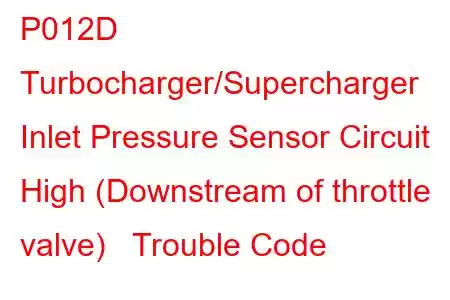P012D Turbo/Supercharger Inlet Pressure Sensor High
OBD-II Trouble Code Technical Description
Turbocharger/Supercharger Inlet Pressure Sensor Circuit High (Downstream of throttle valve)
What does that mean?
This diagnostic trouble code (DTC) is a generic powertrain code, which means that it applies to OBD-II equipped vehicles that have a turbocharger or supercharger inlet pressure sensor. Brand of vehicles may include but are not limited to Ford, Dodge, Saturn, Nissan, Subaru, Honda, etc. Although generic, the specific repair steps may vary depending on make/model/engine.
This particular code indicates a high condition within the Turbo/Supercharger Inlet Pressure Sensor (TCIP) circuit. The turbo/supercharger are responsible for increasing "volumetric efficiency" (amount of air) within the combustion chamber by creating pressure within the intake system.
Generally speaking Turbochargers are exhaust driven and Superchargers are belt driven. The inlet of the turbo/supercharger is where they get their filtered air from the air filter. The inlet sensor works with the ECM (Electronic Control Module) or PCM (Powertrain Control Module) in order to monitor and regulate intake pressure.
The "(Downstream of throttle valve)" indicates what specific inlet sensor has the malfunction and it's location. The pressure sensor may also incorporate a temperature sensor into it.
This trouble code is closely related to P012A, P012B, P012C, and P012E.
What are some of the symptoms of the code?
Symptoms of a P012D engine code may include:
Vehicle enters limp mode (Fail safe mode) Engine noises Poor performance Engine misfiring Stalling Poor fuel mileageWhat are some of the common causes of the code?
Causes for this code may be:
Defective Turbo/supercharger inlet pressure sensor Broken or damaged wiring harness Problem within general electrical system ECM issue Pin/connector problem. (i.e. corrosion, overheating etc.) Clogged or damaged air filterWhat are some of the troubleshooting steps?
Be sure to check for technical service bulletins (TSBs) for your vehicle. Getting access to a known fix can save you time and money during diagnosis.
2013 Ford F150 EcoBoost P012B / P012D Bulletin 14-0082
One known bulletin, for example, is Ford TSB 14-0082 which applies to 2013 Ford F-150 pickups with the 3.5L EcoBoost V6 engine. If you have a P012B and/or P012D code with that vehicle, here is a PDF copy of the full bulletin. The fix is to replace the sensor & connector with updated parts, wire part number BU2Z-14S411-ATA and sensor part number CV2Z-9F479-A. Summary below:
Some 2013 F-150 vehicles equipped with a 3.5L GTDI engines may exhibit a MIL illuminated with diagnostic trouble code (DTC) P012B (turbocharger/supercharger inlet pressure sensor circuit range/performance) and/or P012D (turbocharger/ supercharger inlet pressure sensor circuit high) stored in powertrain control module (PCM) memory.
Tools
Whenever you are working with electrical systems, some of the basic tools that are a good idea to have are:
OBD code reader Multimeter Basic socket set Basic ratchet and wrench sets Basic screwdriver set Rag/shop towels Battery terminal cleaner Service manualSafety Tips
Let engine cool Chalk wheels Wear PPE (Personal protective equipment)Basic Step #1
Visually inspect the TCIP and surroundings. Given the nature of these codes, it is highly likely there is some sort of physical problem causing this issue. That being said, check the harness thoroughly because the harness’ for these sensors typically run along areas where extremely high temperatures are present. In order to locate which sensor’s circuit is malfunctioning refer to "Downstream of Throttle valve". Downstream meaning after the throttle valve or the si
Read: 45


